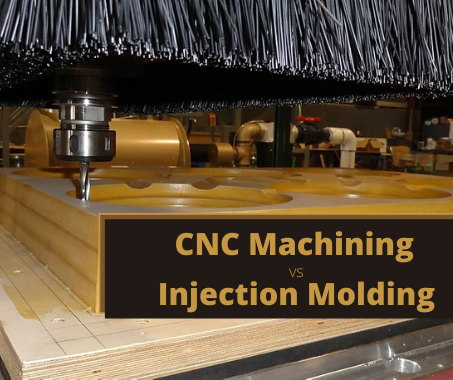Well-shaped, durable, and aesthetically appealing plastic parts are an integral part of our lives. They are used in various commercial and industrial applications. Have you ever wondered how these parts are produced and why manufacturers choose specific techniques? Great! This post focuses on two popular techniques – CNC plastic machining and injection molding. These techniques and their advantages and shortcomings are explained through a fair overview of CNC machining vs. injection molding.

CNC plastic machining and injection molding are not new techniques; however, they are exceptionally popular. The following pointers will help you understand each better.
• CNC Plastic Machining:CNC stands for computer numerical control and it is a material removal technique. The material is removed from solid blocks following computer commands. The information is sourced from a digital file or CAD. This enables manufacturers to make alterations between the files. These files are broken down into commands that are fed to milling tools, which help produce the final product in the required shape and size.
• Injection Molding:As the name suggests, this is a molding technique where parts are produced from molds. The thermoplastic is heated and molten material is injected into the mold at high pressure. This material is directed to move along channels or runners and then to the mold. Once the process completes, the mold is opened and the finished part is ejected from it. This process is repeated until all parts are produced. Hydraulic or electric machines are used for injection molding. This process produces precision-designed parts at high rates.
CNC plastic machining and injection molding both are extremely popular with manufacturers, and each is suitable for certain applications based on their strengths. Read the following points of comparison to understand it better.
• Speed: When compared between the two, CNC machining is the fastest technique; however, it is suited for mid to low volume production. Alternatively, injection molding is the best way to produce high-volume parts, albeit at a slower pace. This is because injection molding utilizes a mold, and the mold making itself is a tedious process. Sometimes it may take a few weeks or up to a few months to produce a mold with precision to meet tighter tolerances. Once the mold is decided, part creation is an easy process. The time taken to create a mold often pays off through high volume production.
• Material Compatibility: Vast material compatibility is an advantage of CNC plastic machining. It is compatible with acrylic, polycarbonate, ABS, PVC, and various types of specific plastic and high-performance plastic. On the contrary, the material selection is quite limited when it comes to plastic injection molding. Often CNC machining is preferred over injection molding when it comes to working with several hard plastic types.
• Cost of Production: Cost of production is one of the important considerations when it comes to choosing between machining and molding. Generally, with CNC, a CAD file is created and converted to a series of commands that are used by the machine. Owing to the evolution of software, this process is much cheaper now. However, injection molding utilizes a mold, which may take several months to prepare, thereby adding to the cost and overall time.
• Surface Finish: In injection molding, the cooled part is ejected from the mold using ejector pins. At times, this may lead to cosmetic imperfections on the surface of the ejected part. Often times, but not always, these imperfections can be cured through post-production processes. Although this may work for some parts, CNC machining is more preferable for parts which demand high aesthetic appeal.
• Tolerances: Tolerance is a term for acceptable variation in the final product, which enables users to fit various end-use parts, and use them as intended. The CNC machines enable to cut workpieces to 0.001" tolerances; however, in injection molding, tolerances of 0.005" are offered. If molds with stricter tolerances are created, then they may drive up the cost of production. Against this, CNC machining assures precise tolerances at much lower costs.
As seen above, when it comes to choosing between machining and molding, CNC machining scores in several areas with its low cost, practicality, and other advantages. Whatever technique you choose, it is important to partner with a trusted and experienced plastic machining services provider like Ehren-Haus. The company specializes in various types of custom plastic fabrication services. The company has been providing CNC plastic machining services to its industrial clients for several years now.